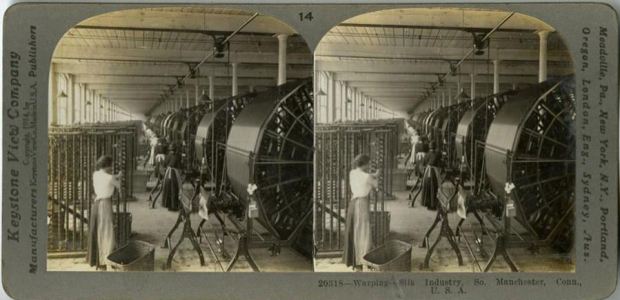By Emma Curry-Stodder for Your Public Media
Looking at stereo views was a popular form of home entertainment throughout the second half of the 19th century and on into the early 20th century. Stereo views were taken with a special camera with two lenses, resulting in two nearly identical photographs which created a 3-D effect when placed side-by-side on a cardboard mount and seen through an optical device called a stereopticon. Stereo views can be seen as a sort of proto-cinematic experience before the age of film. In an age when travel was more difficult and expensive than it is today, these views provided a way for people to experience far-off locales in the comfort of their own homes. While typical subjects included sites such as the pyramids of Giza or Jerusalem from the vantage of Mount Zion, many also recorded sights closer to home. The stereo views in the John S. Craig Collection, acquired by the Connecticut Historical Society in 2012, provide a fascinating glimpse of 19th-century Connecticut.
Normal
0
false
false
false
EN-US
X-NONE
X-NONE
MicrosoftInternetExplorer4

Dead Bat. Photograph by W. H. Jennings, Norwich. The bat appears to be a biological specimen, mounted for display – Connecticut Historical Society, John S. Craig Collection
Subjects in the Craig Collection include views of Connecticut towns, often taken as part of a series (for example, “Views of Norwich and the Surrounding Vicinity”). Street scenes feature stores, office buildings, churches, schools, and houses. An entire series taken in 1914 shows the process of weaving and dying silk at the Cheney Silk Factory in Manchester. Natural disasters were popular, with many pictures of events such as the Wallingford Tornado of 1878 and the Spring Flood at Norwich in 1876. Other stereo views capture the ordinary activities of people: parades and fairs, military drills and encampments, bands playing to crowds at Lake Compounce, families playing croquet on their front lawns. Portraits of families and individuals were also commissioned. Unusual subjects include a funeral wreath, a pipe, and even a dead bat.
Emma Curry-Stodder, an intern, worked to accession, catalogue, and scan the John S. Craig Collection in the Graphics Collection at the Connecticut Historical Society
© Connecticut Public Broadcasting Network and Connecticut Historical Society. All rights reserved. This article originally appeared on Your Public Media.
Note: ConnecticutHistory.org does not edit content originally published on another platform and therefore does not update any instances of outdated content or language.








